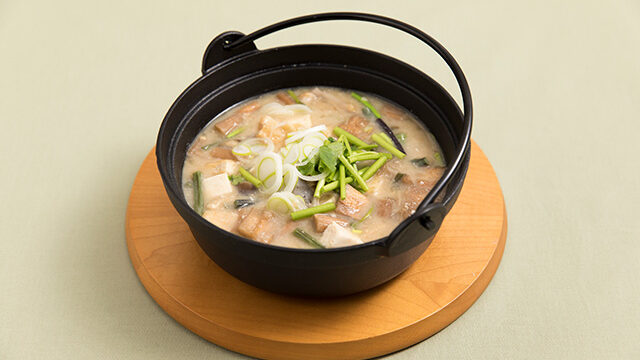
Alright, buckle up, buttercups! You might think you know natto (fermented soybeans), but have you ever had it in a soup? Up here in Yamagata, “Nattojiru” is a real stick-to-your-ribs kind of dish, especially when the snow starts flying. Let’s dive into this unique local flavor!
Dish Name: Nattojiru
- Region / Location: Yamagata Prefecture (throughout the prefecture).
- Primary Area of Tradition: Throughout Yamagata Prefecture.
- Main Ingredients: Natto (fermented soybeans), tofu, deep-fried tofu (aburaage), wild vegetables (sansai), dried taro stems (imogara), konnyaku (yam cake), mushrooms, green onions (negi), Japanese parsley (seri), miso.
How It’s Eaten / Served
Nattojiru is a hearty soup that’s perfect for warming you up on a cold winter day. The key is to thoroughly mash the natto in a mortar until you can’t see the individual beans anymore. This creates a thick, creamy base that blends beautifully with the broth. It’s usually packed with other ingredients like tofu, fried tofu, various mountain vegetables, dried taro stems, konnyaku, mushrooms, and seasoned with miso.
Cultural Background and Preservation
Back in the day in Yamagata, with long, harsh winters and limited fresh food, folks often made their own natto as a way to preserve soybeans. They’d wrap cooked soybeans in rice straw and keep them warm near the kotatsu (heated table) to ferment. In the Oe and Murayama areas, if the natto didn’t get stringy, they’d turn it into Nattojiru!
This soup has been a beloved winter staple in Yamagata for ages. The dried taro stems (“imogara”) are a must-have ingredient. Along with other preserved foods like dried fish and salted veggies, and the addition of tofu and fried tofu, it was a valuable source of protein during the colder months.
Interestingly, Nattojiru isn’t just for winter. In the Murayama region, it’s sometimes eaten during the Shichigusa (seven herbs) festival, in the Mogami region on New Year’s Day, and in the Shonai region during “Daikokusama no Toshiya” (the night when Daikoku, the god of wealth, is said to welcome his wife). Because fresh spring herbs are hard to come by in early spring in snowy areas, having Nattojiru with preserved foods during the Shichigusa festival is a way to pray for good health throughout the year. In the Shonai region, on “Daikokusama no Toshiya” (December 9th) and New Year’s Eve, it’s part of a meal that also includes roasted beans, roasted rice, and a special two-pronged daikon radish, all to celebrate a good harvest and family prosperity.
While it’s becoming less common for families to make Nattojiru from scratch these days because it takes time, you can still find it on the menu at local inns, restaurants, and even school lunches, where it’s apparently a big hit! To make it easier for folks at home, you can even buy “Nattojiru sets” at supermarkets, which have all the basic ingredients ready to go.
Additional information:
- Imogara (いもがら): Dried stems of the taro plant (Colocasia esculenta). They are rehydrated and then used in soups and stews, providing a slightly chewy texture.
- Sansai (山菜): Wild mountain vegetables. This can include a variety of seasonal edible plants like ferns, wild greens, and mountain herbs, which add a unique flavor and texture to the soup.
- Aburaage (油揚げ): Thin slices of tofu that have been deep-fried until golden brown. They absorb the flavor of the broth and add a slightly chewy texture.
- Konnyaku (こんにゃく): A jelly-like food made from the starch of the konnyaku potato (Amorphophallus konjac). It has a unique texture and is often used in Japanese stews and soups.
- Shichigusa (七草): The seven spring herbs traditionally eaten in a rice porridge (nanakusa-gayu) on January 7th to wish for good health in the new year.
- Kotatsu (こたつ): A traditional Japanese heating appliance consisting of a low table covered by a futon (heavy blanket) with a heat source underneath.
The information about regional cuisine featured on this website (Piggy's Grandma of Japan) is summarized and adapted from the Ministry of Agriculture, Forestry and Fisheries of Japan (MAFF) website, "Our Regional Cuisines"Additional commentary is provided based on the unique experiences and perspectives of the site's editors.
The copyright for the original content regarding regional cuisine belongs to the Ministry of Agriculture, Forestry and Fisheries of Japan.
The summaries and adaptations published on this site are intended for informational purposes only. Piggy's Grandma of Japan does not guarantee the accuracy or completeness of this information. For the most accurate and complete details, please refer to the original pages on the MAFF website.


